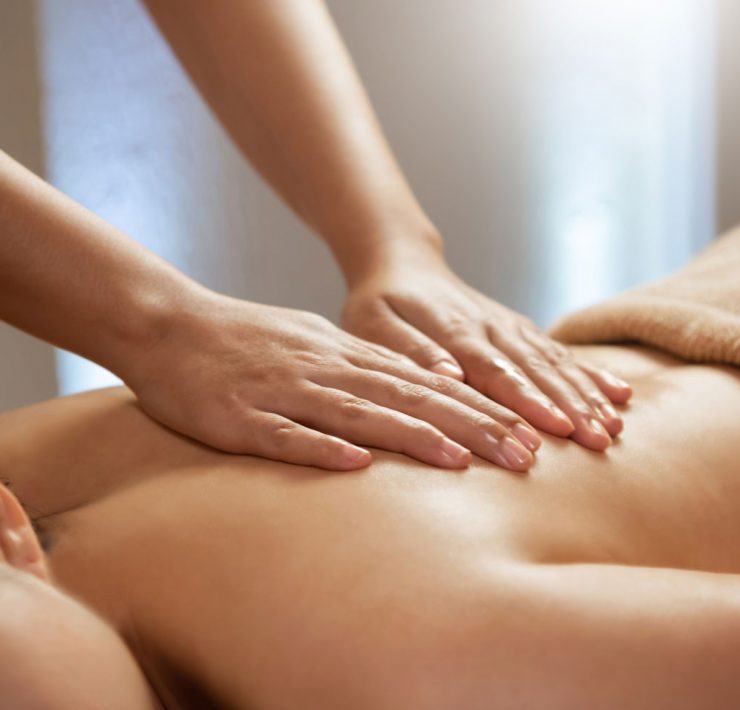Massage is a proven and ancient solution for your musculoskeletal aches and pains, but did you know it can improve your digestive health, too? Massage can aid in digestion through the parasympathetic nervous system, the muscles and fascia surrounding the digestive system, and through complementing peristalsis. These effects can be achieved indirectly from a full-body massage, directly through a professional abdominal massage, and through self-massage on your abdomen.
How do each of these digestion-friendly techniques work?
How Full-Body Massage Supports Digestion
Before we talk about massage’s effects on digestion, we will need a quick refresher on the autonomic nervous system, which controls involuntary physiologic processes like heart rate, blood pressure, respiration, and digestion. The sympathetic and parasympathetic nervous systems both belong to the autonomic nervous system, but work in opposition to each other.
The sympathetic nervous system drives the “fight or flight” response in stressful situations, while the parasympathetic nervous system predominates in quieter situations, sometimes referred to as “rest and digest.” The main goal of the parasympathetic nervous system is to conserve energy to be used later and to regulate bodily functions like digestion and sleep.
A typical full-body massage induces a switch from the sympathetic to the parasympathetic system. One of the key functions of the parasympathetic system is digestion, with documented increases in salivation, and secretory and peristaltic activities.
After your next massage, see if you can identify the parasympathetic response in your own body—increased relaxation, lower heart rate and blood pressure, lowered respiration rate, and increased appetite are all indicators of the switch from sympathetic to parasympathetic.
Using Abdominal Massage to Improve Digestion
The abdomen is a container for organs, blood vessels, fascia, and muscles. Sometimes, especially in the event of direct trauma or acceleration-related trauma, the muscles and fascia can become extra tense, tight, and knotted. Additionally, conditions like collapsed posture, emotional distress, endometriosis, and pregnancy can affect the muscles and fascia in your abdominal cavity. All of this can result in troubled digestion.
Abdominal massage can be employed to manipulate the muscles and surrounding tissues of the entire abdominal cavity. The effect will be to loosen the tonicity of the muscles, allowing the organs and muscles to re-settle into a healthy position.
Any licensed or certified massage therapist is equipped to perform a basic abdominal massage, but you can also find therapists who specialize in it. You may see this specialty referred to as “visceral massage,” “visceral manipulation,” or “therapeutic abdominal massage.”
An abdominal massage can be the sole focus of a massage session or simply one portion of a session. As with any massage, if you’d like to add abdominal work to your treatment, be sure to discuss it with your massage therapist. They’ll be glad to learn about your massage goals, discuss any concerns you have, and advise on possible contraindications.
How You Can Use Self-Massage to Improve Digestion
One of the most common causes of bellyaches is constipation or gas in your intestines. Of course, there are many conditions that can cause lower abdominal pain, so be sure to check in with a medical professional if needed. But, if your bellyache is caused by constipation or gas, a simple self-massage technique can provide significant relief.
Generally, most humans’ intestines eliminate waste through the large intestine in a clockwise direction. Keeping that in mind, use a loose fist or a broad palm and trace your entire abdomen in a clockwise direction, slowly and lightly, adjusting pressure and pace to feel most comfortable for you.
The size and shape of the circle you trace over your abdomen should be hip to hip below your belly button, then up toward your ribcage, across your midsection just below the ribs, and then back down to your hip. Aim for a minimum of 5 seconds per rotation with gentle pressure (perhaps the amount you’d use to pet a new-to-you dog).
This self-massage technique complements peristalsis, which is an involuntary muscular action of the large intestine which pushes contents forward. Self-massage of the abdomen is a good life skill to keep in your pocket for your next bellyache.
Incorporating massage into your wellness routine can be a gentle yet powerful way to support healthy digestion. Remember that complementary medicine should not be a replacement for medical advice, so if you have chronic or abnormally painful bellyaches, consult a medical professional.
Melanie Peddle holds a MS in Mechanical Engineering and has been practicing massage since 2012. She is an instructor with Western Colorado University in its partnership with the University of Colorado, focusing on biomechanical engineering and injury, as well as applications in adaptive sports. An accomplished collegiate athlete, Melanie brings an engineer's mind to all her physiological pursuits, and a passion for the most interesting engineering challenge of all: the human body.







